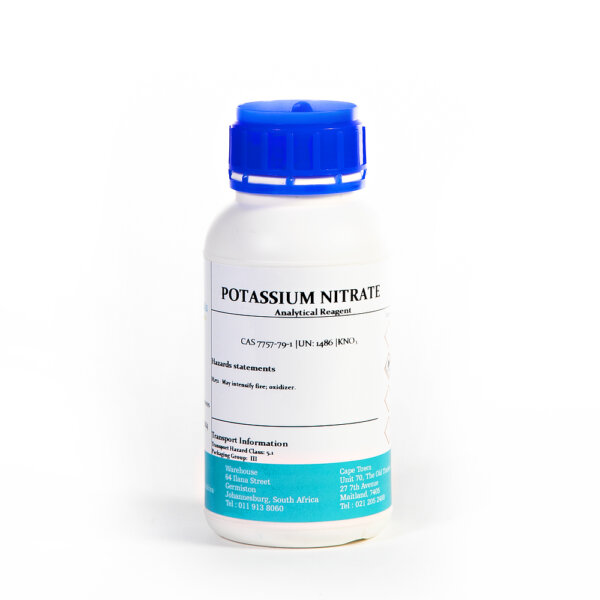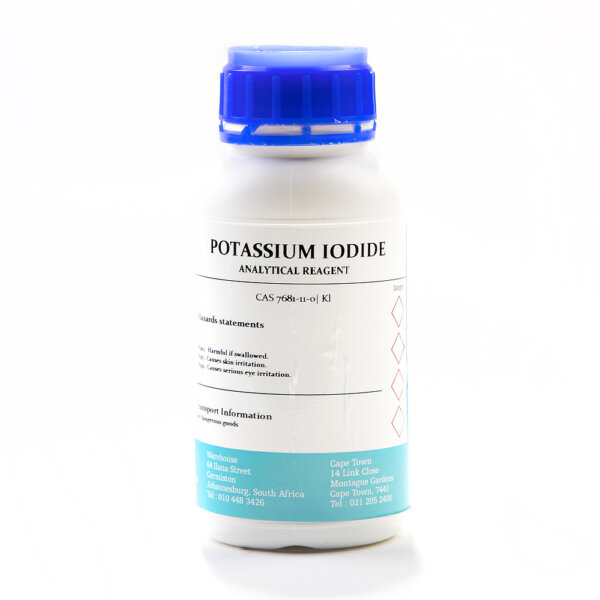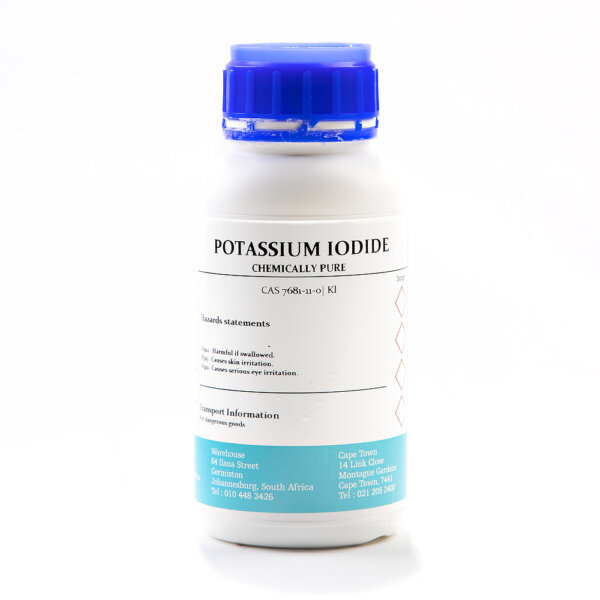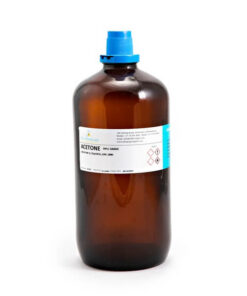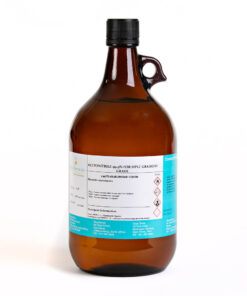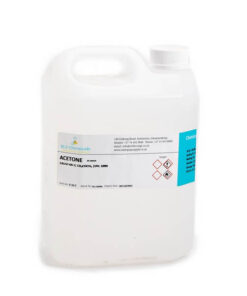Potassium Iodide CP – 500g
R1,287.99 Ex VAT
Potassium Iodide CP – 500g
Potassium Iodide CP – Identification of Product Chemical Code: CHE-P14 Chemical Name: Potassium Iodide Chemical Grade: Chemical Formula: IK Chemical Weight: 166,00 g/mol CAS No: 7681-11-0 Chemical Synonyms: Potassium Iodide CP – Hazards Identification REACH No: No Data Available Signal Word: Warning Supplemental Hazard Information: Additional Hazard Information: No Data Available Potassium Iodide CP – Hazards statements H302 – Harmful if swallowed. H315 – Causes skin irritation. H319 – Causes serious eye irritation. Potassium Iodide CP – Precautionary statements P305 + P351 + P338 – IF IN EYES: Rinse cautiously with water for several minutes. Remove contact lenses, if present and easy to do. Continue rinsing. Potassium Iodide CP – Composition of Chemical Chemical Formula: IK EC No 1272/2008: No Data Available First Aid Measures General Advice: Consult a physician. Show this safety data sheet to the doctor in attendance. If: Inhaled: If breathed in, move person into fresh air. If not breathing, give artificial respiration. Consult a physician. If: Skin Contact: Wash off with soap and plenty of water. Consult a physician. If: Eye Contac: Rinse thoroughly with plenty of water for at least 15 minutes and consult a physician. If: Swallowed: Never give anything by mouth to an unconscious person. Rinse mouth with water. Consult a physician. Important Symptoms: The most important known symptoms and effects are described in the labeling section. Immediate Medical Attention: No Data Available Firefighting Measures Extinguishing Media: Dry powder Hazards Arising: Sulphur oxides, Potassium oxides. Advice for Firefighters: Wear self contained breathing apparatus for fire fighting if necessary. Info for Firefighting: No Data Available Accidental Release Measures Personal Precautions: Wear respiratory protection. Avoid dust formation. Avoid breathing vapours, mist or gas. Ensure adequate ventilation. Evacuate personnel to safe areas. Avoid breathing dust. Enviromental Precautions: Do not let product enter drains. Method for Containment: Pick up and arrange disposal without creating dust. Sweep up and shovel. Do not flush with water. Keep in suitable, closed containers for disposal. Handling and Storage Personal Precautions: Avoid formation of dust and aerosols. Provide appropriate exhaust ventilation at places where dust is formed. Enviromental Precautions: Store in cool place. Keep container tightly closed in a dry and well-ventilated place. Never allow product to get in contact with water during storage. Do not store near acids. Exposure Controls | Personal Protection Derived No Effect Level (DNEL) Workers | Application Area | Exposure Routes | Health Effect | Value No Data Available Consumers | Application Area | Exposure Routes | Health Effect | Value No Data Available Predicted No Effect Concentration (PNEC) No Data Available Engineering Controls: Handle in accordance with good industrial hygiene and safety practice. Wash hands before breaks and at the end of workday. Eye/Face Protection: Face shield and safety glasses Use equipment for eye protection tested and approved under appropriate government standards such as NIOSH (US) or EN 166(EU). Skin Protection: Handle with gloves. Gloves must be inspected prior to use. Use proper glove removal technique (without touching glove’s outer surface) to avoid skin contact with this product. Dispose of contaminated gloves after use in accordance with applicable laws and good laboratory practices. Wash and dry hands. The selected protective gloves have to satisfy the specifications of EU Directive 89/686/EEC and the standard EN 374 derived from it. Full contact Material: Nitrile rubber Minimum layer thickness: 0,11 mm Break through time: 480 min Material tested: Dermatril® (KCL 740 / Size M) Splash contact Material: Nitrile rubber Minimum layer thickness: 0,11 mm Break through time: 480 min Material tested: Dermatril® (KCL 740 / Size M) data source: KCL GmbH, D-36124 , test method: EN374 If used in solution, or mixed with other substances, and under conditions which differ from EN 374, contact the supplier of the CE approved gloves. This recommendation is advisory only and must be evaluated by an industrial hygienist and safety officer familiar with the specific situation of anticipated use by our customers. It should not be construed as offering an approval for any specific use scenario. Body Protection: Complete suit protecting against chemicals, The type of protective equipment must be selected according to the concentration and amount of the dangerous substance at the specific workplace. Respiratory Protection: Where risk assessment shows air-purifying respirators are appropriate use a full-face particle respirator type N100 (US) or type P3 (EN 143) respirator cartridges as a backup to engineering controls. If the respirator is the sole means of protection, use a full-face supplied air respirator. Use respirators and components tested and approved under appropriate government standards such as NIOSH (US) or CEN (EU). Physical and Chemical Properties Appearance: Colourless or White crystals or granules or powder Odour: No Data Available Odour Threshold: No Data Available pH: 6,0 – 9 at 166 g/l at 25 °C Melting Point: Melting Point/Range: 681 °C Boiling Point: 1.330 °C Flash Point: No Data Available Evaporation: No Data Available Flammability: No Data Available Upper/Lower Flammability or Explosive Limits: No Data Available Vapour pressure: 1 hPa at 745 °C Vapour density: No Data Available Relative density: 3,130 g/cm3 Water solubility: No Data Available Partition Coefficien: No Data Available Auto-ignition Temperature: No Data Available Decomposition Temperature: No Data Available Viscosity: No Data Available Explosive properties: No Data Available Oxidizing properties: No Data Available Other Safety Info: Bulk density 1.700 kg/m3 Stability and Reactivity Reactivity: No Data Available Chemical Stability: May decompose on exposure to air and moisture. Stable under recommended storage conditions. Possibility of hazardous reactions: No Data Available Conditions to Avoid: Tin/tin oxides. Incompatible Materials: Strong reducing agents, Nickel, Strong acids, and its alloys, Steel (all types and surface treatments), Aluminum, Alkali metals, Brass, Magnesium, Zinc, cadmium, Copper. Hazardous Decomposition Products: Other decomposition products – No Data Available Toxicological Information Acute Toxicity: LD50 Oral – mouse – 1.000 mg/kg Skin Corrosion/Irritation: Skin – rabbit Result: Irritating to skin. Serious Eye damage | Eye Irritation: Eyes – rabbit Result: Irritating to eyes. – 24 h (Draize Test) Cell Mutagenicity: No Data Available Carcinogenicity: IARC: No component of this product present at levels greater than or equal to 0.1% is identified as probable, possible or confirmed human carcinogen by IARC. Reproductive toxicity: Exposure to excessive amounts of iodine during pregnancy is capable of producing fetal hypothyroidism. Iodine-containing drugs have been associated with fetal goiter. Specific Target Organ Toxicity – Single Exposure: No Data Available Specific Target Organ Toxicity – Repeated Exposure: No Data Available Aspiration Hazard: No Data Available Ecological Information Ecological Toxicity: Toxicity to fish LC50 – Oncorhynchus mykiss (rainbow trout) – 2.190 mg/l – 96 h Toxicity to daphnia and other aquatic invertebrates – EC50 – Daphnia – 2,7 mg/l – 24 h Ecological Persistence and degradability: No Data Available Bioaccumulative Potential: No Data Available Mobility in Soil: No Data Available Results of PBT and vPvB Assessment: PBT/vPvB assessment not available as chemical safety assessment not required/not conducted. Other Adverse Effect: No Data Available Disposal Considerations Waste Treatment Methods: Product Offer surplus and non-recyclable solutions to a licensed disposal company. Contaminated packaging Dispose of as unused product Transport Information UN Number: ADR/RID: – IMDG: – IATA: – UN Shipping Hazard: ADR/RID: Not dangerous goods IMDG: Not dangerous goods IATA: Not dangerous goods Transport Hazard Class: ADR/RID: – IMDG: – IATA: – Packaging Group: ADR/RID: – IMDG: – IATA: – Enviromental Hazards: ADR/RID: no IMDG Marine pollutant: no IATA: no Special Precautions: No Data Available Regulatory Information Safety, Health and environmental regulations: This safety datasheet complies with the requirements of Regulation (EC) No. 1907/2006. Chemical Safety Assessment: For this product a chemical safety assessment was not carried out. Additional Info: RTECS: TT2975000 Prolonged exposure to iodides may produce iodism in sensitive individuals. Symptoms of exposure include: skin rash, running nose, headache and irritation of the mucous membrane. For severe cases the skin may show pimples, boils, hives, blisters and black and blue spots. Iodides are readily diffused across the placenta. Neonatal deaths from respiratory distress secondary to goiter have been reported. Iodides have been known to cause drug-induced fevers, which are usually of short duration. Liver – Irregularities – Based on Human Evidence.
CAS Number: 584-08-7 Synonyms: Carbonate of Potash, Dipotassium Carbonate, Sub-Carbonate of Potash
• Chemical Code: CHE-P14
• Chemical Name: Potassium Iodide
• Chemical Grade: CP
• Chemical Formula: IK
• Chemical Weight: 166,00 g/mol
• CAS No: 7681-11-0
• Chemical Synonyms: NA
• Appearance: Colourless or White crystals or granules or powder
• pH: 6,0 – 9 at 166 g/l at 25 °C
• Melting Point: 681 °C
• Boiling Point: 1.330 °C
• Relative density: 3,130 g/cm3
• Bulk density: 1.700 kg/m3
• Chemical Formula: IK
• Chemical Weight: 166,00 g/mol
• CAS No: 7681-11-0
• Appearance: Colourless or White crystals or granules or powder
• pH: 6,0 – 9 at 166 g/l at 25 °C
• Melting Point: 681 °C
• Boiling Point: 1.330 °C
• Relative density: 3,130 g/cm3
• Bulk density: 1.700 kg/m3
Related products
Lab Chemicals
Lab Chemicals
Lab Chemicals
Lab Chemicals
Lab Chemicals
Lab Chemicals
Lab Chemicals
Lab Chemicals
